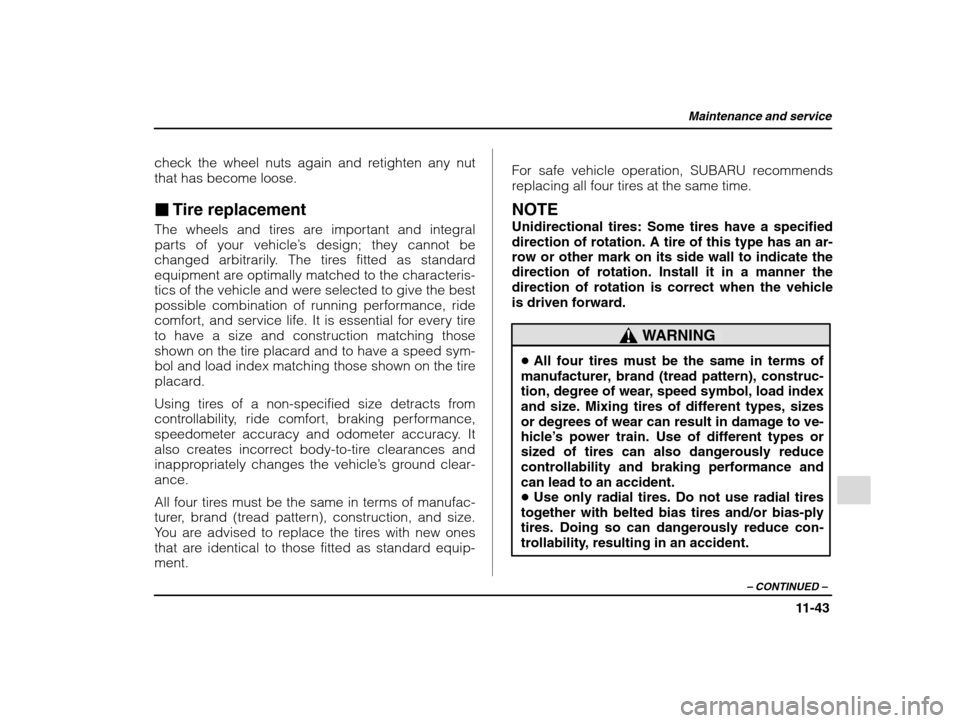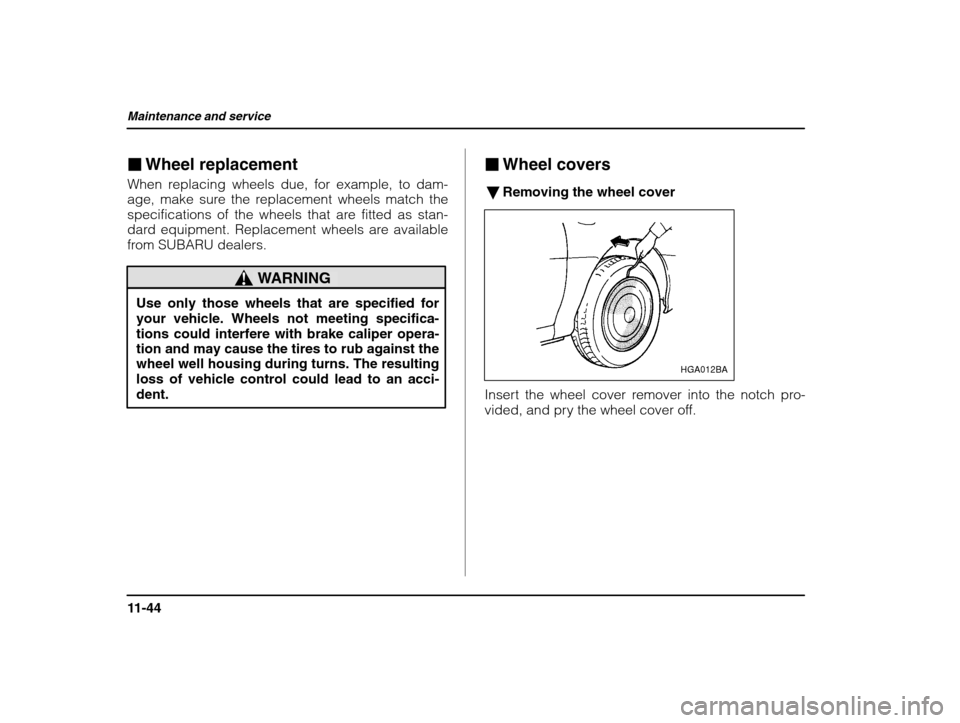2002 SUBARU IMPREZA WRX wheel
[x] Cancel search: wheelPage 333 of 390

Maintenance and service
11-36
CAUTION
If you continue to drive despite the scraping noise from the audible brake pad wear indica-
tor, it will result in the need for costly brake rotor repair or replacement.
� Breaking-in of new brake pads and linings
When replacing the brake pad or lining, use only
genuine SUBARU parts. After replacement, the new
parts must be broken in as follows:
� Brake pad and lining
While maintaining a speed of 30 to 40 mph (50 to 65
km/h), step on the brake pedal lightly. Repeat this
five or more times.
� Parking brake lining
1. Drive the vehicle at a speed of about 22 mph (35km/h).
2. With the parking brake release button pushed in,
pull the parking brake lever SLOWLY and GENTLY.
(Pulling with a force of approximately 33 lb [147 N,15 kg].)
3. Drive the vehicle for about 220 yards (200 me- ters) in this condition. 4. Wait 5 to 10 minutes for the parking brake to cool
down. Repeat this procedure.
5. Check the parking brake stroke. If the parking
brake stroke is out of the specified range, adjust it
by turning the adjusting nut located on the parking
brake lever.
Parking brake stroke: 7 – 8 notches / 44 lb (196 N, 20 kg)
WARNING
A safe location and situation should be se- lected for break-in driving.
CAUTION
Pulling the parking brake lever too forcefully
may cause the rear wheels to lock. To avoid
this, be certain to pull the lever up slowly and
gently.
Page 334 of 390

Maintenance and service
11-37
– CONTINUED –
Parking brake stroke
HB4001CA
Check the parking brake stroke according to the
maintenance schedule in the “Warranty and Mainte-
nance Booklet ”. When the parking brake is properly
adjusted, braking power is fully applied by pulling
the lever up seven to eight notches gently but firmly(about 44 lb, 196 N, 20 kg). If the parking brake le-
ver stroke is not within the specified range, have the brake system checked and adjusted at your
SUBARU dealer. Tires and wheels �
Types of tires
� All season tires
All season tires are designed to provide an ade-
quate measure of traction, handling and braking
performance in year-round driving including snowy
and icy road conditions. However all season tires do
not have adequate traction performance compared
with winter (snow) tires in heavy or loose snow or on
icy road.
All season tires are identified by “ALL SEASON ”
and/or “M+S” (Mud & Snow) on the tire sidewall.
� Summer tires
Summer tires are high-speed capability tires best
suited for highway driving under dry conditions.
Summer tires are inadequate for driving on slippery
roads such as on snow-covered or icy roads.
If you drive your vehicle on snow-covered or icy
roads, we strongly recommend the use of winter
(snow) tires.
When installing winter tires, be sure to replace all
four tires.
� Winter (snow) tires
Winter tires are best suited for driving on snow-cov-
Page 335 of 390

Maintenance and service
11-38
ered and icy roads. However winter tires do not
have adequate performance compared with sum-
mer tires and all season tires on roads other than
snow-covered and icy roads. �Tire inspection
Check on a daily basis that the tires are free from serious damage, nails, and stones. At the same
time, check the tires for abnormal wear.
Contact your SUBARU dealer immediately if you find
any problem. NOTE � When the wheels and tires strike curbs or are
subjected to harsh treatment as when the vehicle is driven on a rough surface, they can suffer
damage that cannot be seen with the naked eye.This type of damage does not become evident
until time has passed. Try not to drive over
curbs, potholes or other rough surface. If doingso is unavoidable, keep the vehicle ’s speed
down to a walking pace or less, and approach
the curbs as squarely as possible. Also, makesure the tires are not pressed against the curbswhen you park the vehicle.� If you feel unusual vibration while driving or
find it difficult to steer the vehicle in a straight line, one of the tires and/or wheels may be dam-aged. Drive slowly to the nearest authorized
SUBARU dealer and have the vehicle inspected. �
Tire pressures and wear
Maintaining the correct tire pressures helps to maxi-
mize the tires ’ service lives and is essential for good
running performance. Check and, if necessary, ad-
just the pressure of each tire (including the spare) at least once a month (for example, during a fuel stop)
and before any long journey.
Check the tire pressures when the tires are cold.
Use a pressure gauge to adjust the tire pressures to
the values shown on the tire placard. The tire plac-
ard is located on the door pillar on the driver ’s side.
HB0382
Page 338 of 390

Maintenance and service
11-41
– CONTINUED –
increase in temperature could cause tread
separation, and destruction of the tires. Theresulting loss of vehicle control could lead toan accident.
� Wheel balance
Each wheel was correctly balanced when your ve-
hicle was new, but the wheels will become unbal-
anced as the tires become worn during use. Wheel
imbalance causes the steering wheel to vibrate
slightly at certain vehicle speeds and detracts from the vehicle ’s straight-line stability. It can also cause
steering and suspension systems problems and ab-
normal tire wear. If you suspect that the wheels are
not correctly balanced, have them checked and ad-
justed by your SUBARU dealer. Also have them ad-
justed after tire repairs and after tire rotation. NOTE Loss of correct wheel alignment* causes the tires to wear on one side and reduces the ve-
hicle’ s running stability. Contact your SUBARU
dealer if you notice abnormal tire wear.
* : The suspension system is designed to hold each wheel
at a certain alignment (relative to the other wheels and to
the road) for optimum straight-line stability and cornering performance. �
Wear indicators
Each tire incorporates a tread wear indicator, which
becomes visible when the depth of the tread
grooves decreases to 0.063 in. (1.6 mm). A tire must
be replaced when the tread wear indicator appears
as a solid band across the tread.
OM-H0231
A) New tread
B) Worn tread
1) Tread wear indicator
Page 339 of 390

Maintenance and service
11-42
WARNING
When a tire’s tread wear indicator becomes
visible, the tire is worn beyond the acceptable
limit and must be replaced immediately. With atire in this condition, driving at high speeds in wet weather can cause the vehicle to hydro- plane. The resulting loss of vehicle controlcan lead to an accident.
NOTE
For safety, inspect tire tread regularly and re-
place the tires before their tread wear indicators
become visible. �
Tire rotation
OM-H0230
Tire wear varies from wheel to wheel. To maximize
the life of each tire and ensure that the tires wear
uniformly, it is best to rotate the tires every 7,500
miles (12,500 km). Rotating the tires involves switch-
ing the front and rear tires on the right-hand side of
the vehicle and similarly switching the front and rear
tires on the left-hand side of the vehicle. (Each tiremust be kept on its original side of the vehicle.)
Replace any damaged or unevenly worn tire at the
time of rotation. After tire rotation, adjust the tire
pressures and make sure the wheel nuts are cor-
rectly tightened.
After driving approximately 600 miles (1,000 km),
Page 340 of 390

Maintenance and service
11-43
– CONTINUED –
check the wheel nuts again and retighten any nut that has become loose. �Tire replacement
The wheels and tires are important and integral
parts of your vehicle ’s design; they cannot be
changed arbitrarily. The tires fitted as standard
equipment are optimally matched to the characteris-
tics of the vehicle and were selected to give the best
possible combination of running performance, ride
comfort, and service life. It is essential for every tireto have a size and construction matching those
shown on the tire placard and to have a speed sym-
bol and load index matching those shown on the tire
placard.
Using tires of a non-specified size detracts from
controllability, ride comfort, braking performance,
speedometer accuracy and odometer accuracy. It
also creates incorrect body-to-tire clearances and
inappropriately changes the vehicle ’s ground clear-
ance.
All four tires must be the same in terms of manufac-
turer, brand (tread pattern), construction, and size.
You are advised to replace the tires with new ones
that are identical to those fitted as standard equip- ment. For safe vehicle operation, SUBARU recommends
replacing all four tires at the same time. NOTE Unidirectional tires: Some tires have a specified direction of rotation. A tire of this type has an ar-
row or other mark on its side wall to indicate the direction of rotation. Install it in a manner the direction of rotation is correct when the vehicleis driven forward.
WARNING
�
All four tires must be the same in terms of
manufacturer, brand (tread pattern), construc-
tion, degree of wear, speed symbol, load indexand size. Mixing tires of different types, sizesor degrees of wear can result in damage to ve-
hicle’ s power train. Use of different types or
sized of tires can also dangerously reduce
controllability and braking performance andcan lead to an accident.� Use only radial tires. Do not use radial tires
together with belted bias tires and/or bias-ply tires. Doing so can dangerously reduce con-
trollability, resulting in an accident.
Page 341 of 390

Maintenance and service
11-44
�Wheel replacement
When replacing wheels due, for example, to dam-
age, make sure the replacement wheels match the
specifications of the wheels that are fitted as stan-
dard equipment. Replacement wheels are available
from SUBARU dealers.
WARNING
Use only those wheels that are specified for your vehicle. Wheels not meeting specifica-tions could interfere with brake caliper opera-tion and may cause the tires to rub against the wheel well housing during turns. The resulting loss of vehicle control could lead to an acci-dent. �
Wheel covers
� Removing the wheel cover
HGA012BA
Insert the wheel cover remover into the notch pro-
vided, and pry the wheel cover off.
Page 342 of 390

Maintenance and service
11-45
– CONTINUED –
�Installing the wheel cover
HGA013BA
Align the valve with the valve hole in the cover, then fit the cover on the wheel by tapping your hand
evenly around the circumference of the cover. NOTE When any of the wheels is removed and replaced for tire rotation or to change a flat tire, always
check the tightness of the wheel nuts after driv-ing approximately 600 miles (1,000 km). If anynut is loose, tighten it to the specified torque. Aluminum wheels (If equipped)
Aluminum wheels can be scratched and damaged
easily. Handle them carefully to maintain their ap-
pearance, performance, and safety. �
When any of the wheels is removed and replaced
for tire rotation or to change a flat, always check the
tightness of the wheel nuts after driving approxi-mately 600 miles (1,000 km). If any nut is loose,
tighten it to the specified torque.� Never apply oil to the threaded parts, wheel nuts,
or tapered surface of the wheel.� Never let the wheel rub against sharp protrusions
or curbs.� Be sure to fit tire chains on uniformly and com-
pletely around the tire, otherwise the chains mayscratch the wheel. � When wheel nuts, balance weights, or the center
cap replaced, be sure to replace them with genuine
SUBARU parts designed for aluminum wheels.